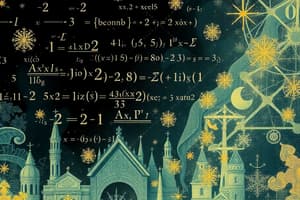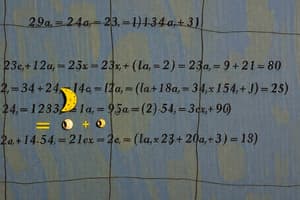Podcast
Questions and Answers
What branch of mathematics uses symbols to represent quantities without fixed values?
What branch of mathematics uses symbols to represent quantities without fixed values?
- Geometry
- Trigonometry
- Calculus
- Algebra (correct)
Constants are symbols representing unknown or changing quantities.
Constants are symbols representing unknown or changing quantities.
False (B)
What are the four basic operations fundamental to algebraic manipulation?
What are the four basic operations fundamental to algebraic manipulation?
addition, subtraction, multiplication, division
In the term 5x, 5 is the ________.
In the term 5x, 5 is the ________.
Match the following terms with their definitions:
Match the following terms with their definitions:
What is the standard form of a quadratic equation?
What is the standard form of a quadratic equation?
The absolute value of a number is always negative.
The absolute value of a number is always negative.
In the equation y = mx + b, what does b represent?
In the equation y = mx + b, what does b represent?
In function notation, f(x) represents the ______ of the function f at x.
In function notation, f(x) represents the ______ of the function f at x.
Match the exponent law with its description:
Match the exponent law with its description:
Flashcards
What are variables?
What are variables?
Symbols that represent quantities without fixed values.
Basic operations in algebra?
Basic operations in algebra?
Addition, subtraction, multiplication, and division.
What are constants?
What are constants?
Fixed values that do not change.
What are terms?
What are terms?
Signup and view all the flashcards
Combining like terms?
Combining like terms?
Signup and view all the flashcards
Substitution Method
Substitution Method
Signup and view all the flashcards
Elimination Method
Elimination Method
Signup and view all the flashcards
Quadratic Equation
Quadratic Equation
Signup and view all the flashcards
Quadratic Formula
Quadratic Formula
Signup and view all the flashcards
Function
Function
Signup and view all the flashcards
Study Notes
- Algebra is a branch of mathematics that uses symbols and rules to manipulate them.
- Symbols in algebra represent quantities without fixed values, known as variables.
- Algebra serves as a generalization of arithmetic.
- Mathematical relationships can be formulated and equations solved using algebra.
Basic Operations
- Addition, subtraction, multiplication, and division are the four basic operations.
- These operations form the basis for algebraic manipulation.
- Understanding the properties of these operations is key to simplifying expressions and solving equations.
Variables and Constants
- Variables are symbols, usually letters, that represent unknown or changing values, examples include x, y, and z.
- Constants are fixed values that do not change; examples include 2, 7, and π.
- Coefficients are numbers multiplied by variables (e.g., in 3x, 3 is the coefficient).
Algebraic Expressions
- Algebraic expressions are made up of variables, constants, and operations; an example is 3x + 2y - 5.
- Terms are the individual components of an expression, separated by + or - signs; in 3x + 2y - 5, the terms are 3x, 2y, and -5.
- Like terms have identical variables raised to the same powers; for example, 3x and 5x.
- Unlike terms have different variables or different powers; for example, 3x and 2y.
Simplifying Expressions
- Combining like terms means adding or subtracting the coefficients of like terms; for example, 3x + 5x = 8x.
- Distributive property: a(b + c) = ab + ac.
- Factoring involves expressing an expression as a product of its factors; for example, x^2 + 2x = x(x + 2).
Equations
- An equation is a statement showing the equality of two expressions; for example, 2x + 3 = 7.
- The objective is to determine the value(s) of the variable(s) that make the equation true.
- Solutions or roots are the values that satisfy the equation.
Solving Linear Equations
- Linear equations contain variables raised to the first power.
- The goal is to isolate the variable on one side of the equation.
- Inverse operations are used to reverse the operations performed on the variable.
- Balance must be maintained by performing the same operation on both sides of the equation.
Examples of Solving Linear Equations
- To solve x + 5 = 9: Subtract 5 from both sides, resulting in x = 4.
- To solve 3x = 12: Divide both sides by 3, resulting in x = 4.
- To solve 2x + 3 = 9: Subtract 3 from both sides (2x = 6), and then divide by 2, resulting in x = 3.
Solving Systems of Linear Equations
- A system of linear equations involves two or more equations that share the same variables.
- Solutions must satisfy all equations in the system simultaneously.
- Substitution, elimination, and graphing can be used to solve these systems.
Substitution Method
- First, solve one of the equations for one variable.
- Then, substitute that expression into the other equation.
- Solve the resulting equation for the remaining variable.
- Finally, substitute the value back into one of the original equations to find the value of the other variable.
Elimination Method
- Multiply one or both equations by a constant so that one variable's coefficients are opposites.
- Add the equations together to eliminate the variable with opposite coefficients.
- Solve for the remaining variable.
- Substitute the value back into one of the original equations to find the value of the eliminated variable.
Quadratic Equations
- A quadratic equation is in the form ax^2 + bx + c = 0, where a ≠ 0.
- Factoring, completing the square, and the quadratic formula can be used to find solutions.
Factoring Quadratic Equations
- Express the quadratic expression as a product of two binomials.
- Set each factor equal to zero and solve for x.
- Example: x^2 - 5x + 6 = (x - 2)(x - 3) = 0, therefore x = 2 or x = 3.
Quadratic Formula
- The quadratic formula is x = (-b ± √(b^2 - 4ac)) / (2a).
- The discriminant (b^2 - 4ac) determines the nature of the roots:
- There are two distinct real roots if b^2 - 4ac > 0.
- There is one real root (a repeated root) when b^2 - 4ac = 0.
- There are two complex roots if b^2 - 4ac < 0.
Functions
- Functions relate a set of inputs to a set of permissible outputs, where each input corresponds to exactly one output.
- The input is called the argument, and the output is the function's value.
- Functions are represented by symbols such as f, g, or h.
Function Notation
- f(x) is the value of the function f at x.
- x is the independent variable, while f(x) is the dependent variable.
- Example: If f(x) = x^2 + 1, then f(3) = 3^2 + 1 = 10.
Domain and Range
- The domain is the set of all possible input values (x-values) for a function.
- The range is the set of all possible output values (f(x)-values) for a function.
Composition of Functions
- The composition of functions f and g, written as (f ∘ g)(x) or f(g(x)), is the function that applies g to x and then applies f to the result.
- Example: If f(x) = x + 1 and g(x) = x^2, then f(g(x)) = f(x^2) = x^2 + 1.
Inequalities
- Inequalities compare two expressions using symbols such as < (less than), > (greater than), ≤ (less than or equal to), and ≥ (greater than or equal to).
- Solving inequalities means finding the range of values that satisfy the inequality.
Solving Linear Inequalities
- Solving linear inequalities is similar to solving linear equations, but multiplying or dividing by a negative number reverses the inequality sign.
- Example: To solve -2x < 6, divide by -2 and reverse the sign: x > -3.
Absolute Value
- The absolute value of a number is its distance from zero, written as |x|.
- |x| is always non-negative.
- |x| = x if x ≥ 0, and |x| = -x if x < 0.
Solving Absolute Value Equations
- To solve |x| = a, consider two cases: x = a and x = -a.
- Example: To solve |x - 2| = 3, solve x - 2 = 3 or x - 2 = -3, so x = 5 or x = -1.
Exponents
- Exponents indicate how many times to multiply a base by itself.
- x^n means multiplying x by itself n times.
- Laws of exponents provide rules for manipulating expressions with exponents.
Laws of Exponents
- Product of powers: x^a * x^b = x^(a+b).
- Quotient of powers: x^a / x^b = x^(a-b).
- Power of a power: (x^a)^b = x^(ab).
- Power of a product: (xy)^a = x^a * y^a.
- Power of a quotient: (x/y)^a = x^a / y^a.
- Zero exponent: x^0 = 1 (if x ≠ 0).
- Negative exponent: x^(-a) = 1 / x^a.
Radicals
- A radical (√) represents the root of a number.
- √x is the square root of x.
- ∛x is the cube root of x.
Simplifying Radicals
- Radicals are simplified by factoring out perfect squares (or cubes, etc.).
- Example: √12 = √(4 * 3) = √4 * √3 = 2√3.
Rationalizing the Denominator
- Removing radicals from the denominator of a fraction is called rationalizing the denominator.
- Multiply the numerator and denominator by a suitable expression.
- Example: To rationalize 1/√2, multiply by √2/√2 to get √2/2.
Polynomials
- Polynomials are expressions with variables and coefficients, involving addition, subtraction, multiplication, and non-negative integer exponents of variables.
- Examples of polynomials: x^2 + 3x - 4 and 5y^3 - 2y + 1.
Operations with Polynomials
- To add or subtract polynomials, combine like terms.
- To multiply polynomials, use the distributive property.
- To divide polynomials, use polynomial long division or synthetic division.
Factoring Polynomials
- Factoring is expressing a polynomial as a product of simpler polynomials or monomials.
- Common techniques include: finding the Greatest Common Factor (GCF), using the difference of squares, recognizing perfect square trinomials, and grouping.
Graphing Linear Equations
- Linear equations are graphically represented as straight lines on a coordinate plane.
- The standard form of a linear equation is y = mx + b, where m is the slope and b is the y-intercept.
- Slope measures the steepness of the line.
- The y-intercept indicates where the line intersects the y-axis.
Studying That Suits You
Use AI to generate personalized quizzes and flashcards to suit your learning preferences.




